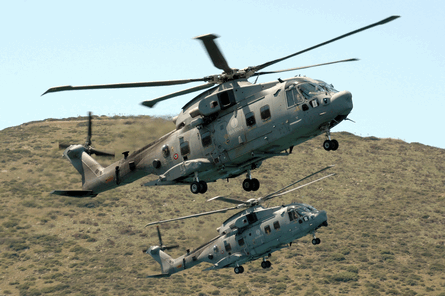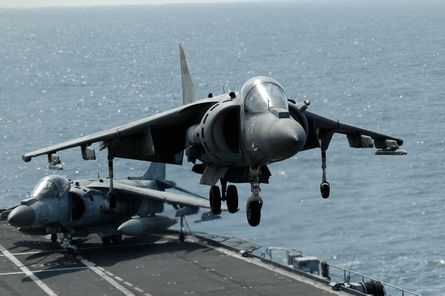To cope with new challenges from conventional and asymmetrical threats and provide a more flexible and capable organic capability, the Italian fleet air arm is involved in a recapitalisation programme that will see legacy rotary- and fixed-wing assets replaced with new-generation platforms including AgustaWestland AW101 and NH Industries NH90 helicopters, and in the mid-term, Lockheed Martin F-35B Lightning IIs.
Meanwhile, navy fleet power projection capabilities are being significantly enhanced with the delivery in 2008 and entry into service next year of the Cavour aircraft carrier.
Although there was a 20% reduction in flying hours from 2004 to 2007, shrewd employment of available resources and accurate risk management has allowed the fleet air arm to continue to satisfy operational tasks, including advance training, in addition to international, NATO and European Union operational missions such as its deployment of helicopters in Afghanistan or on board vessels in the waters around the Horn of Africa.
 |
|---|
© Italian Navy |
Featuring one of the lowest ratios of personnel to aircraft (7:1) in the NATO naval aviation community, Italy's fleet air arm has an inventory of around 90 rotary- and fixed-wing assets, with 200 pilots distributed between three air stations and six flying squadrons, including one with STOVL fighters. Introduced progressively into service since 2001, the AW101 fleet stands at 20 helicopters, with eight in anti-submarine/anti-surface (ASW/ASuW) configuration, four in helicopter early warning (HEW) configuration and eight configured asamphibious support helicopters (ASH).
Two additional AW101 ASW/ASuWs are to be received in 2009, with a requirement for two more. These will replace the Sikorsky SH-3D, which will be retired by next year, with the AW101 ASW/ASuW helicopters to be relocated from Luni in northern Italy to Catania in Sicily. The type will also later replace six combat search and rescue-configured SH-3Ds, equipped with machine guns and ballistic protection for amphibious operations.
"The entry into service of the AW101, equipped with HELRAS low-frequency active dipping sonar, has revolutionised ASW tactics and procedures, allowing one helicopter to cover maritime areas of dimensions inconceivable until a few years ago," says Rear Adm Paolo Treu, head of the Italian fleet air arm.The navy is investing heavily in the development of tactics and procedures for bi-static and multi-static use of the HELRAS sonar.
In adverse sea conditions, the HELRAS-equipped AW101s achieved interesting results in an ASW-oriented Spontex exercise, which is held biannually in the Biscaglia Gulf, successfully challenging other Thales Underwater Systems Flash-mounted ASW helicopters. Integration activities with the MBDA Marte Mk2/S anti-ship missile system were conducted in 2008, and the entire fleet retrofit will be completed by September 2009.
The air arm has completed the final evaluation phase of Selex Galileo HEW-784 radar mounted on the AW101 HEW. Integration of inverse synthetic aperture radar with the HEW-784 is to start shortlyfor completion in 2012.
FLYING HOURS
The eight AW101 ASH variants have already logged around 1,800 flying hours (including 1,000 during NATO and national exercises) supporting both conventional and special forces. Each capable of carrying up to 25 soldiers, 11 litters or a light vehicle, the four aircraft in the second batch will be equipped with a more sophisticated mission suite, including digital maps, Selex new-generation identification friend-or-foe satellite communications radios, FLIR Systems Star Safire II electro-optical/infrared, a pilot-downed positioning system, and a defensive aid subsystem with Elettronica radar warning receivers, an EADS/Selex missile warning system, a Selex laser warning system, and a chaffs/flares intelligent dispenser suite. An ASH gunship configuration is being finalised.
 |
|---|
The 30 or so ASW/ASuW and six heli-assault dedicated Agusta/Bell AB212s, will progressively be replaced by the NH90, to be acquired in 46 platforms for ASW/AsuW missions and 10 in a TTH navalised version for amphibious and special forces support duties. "We expect to receive the first ASW/ASuW fully equipped helicopter, including final operational mission suite, by 2011. To compensate for programme delivery delays, a number of AB212s will undergo a life-extension programme that will keep them in service until 2016, when the NH90 phase-in and operational certification will be completed," Treu says.
The new NH90 in the ASW/ASuW and ASH versions will represent a major technological leap forward from the legacy AB212s, employing a fly-by-wire flight control system and an integrated mission system including a surface search radar, electronic support measures and an AW101 HELRAS dipping sonar equipped with a Selex Galileo-provided common acoustics processor used also for embarked acoustic buoys.
In addition to the three Piaggio P180 Maritime aircraft for surveillance and transport duties, the fixed-wing fleet is composed of 15 Boeing/Alenia Aeronautica AV-8B Harrier II Plus and two TAV-8B operational conversion aircraft. Based at Grottaglie air station near Taranto, the aircraft have air-to-air AMRAAM and Sidewinder missiles and can carry a range of air-to-ground armaments, including non-guided or guided laser munitions, thanks to a Rafael/Northrop Grumman Litening II targeting pod. The fleet air arm will also receive 227kg (500lb) JDAM munitions.
"These aircraft will be progressively replaced by 22 Joint Strike Fighters in the STOVL version," says Treu."The delivery schedule will begin in 2014 and will see two to three aircraft a year until 2020. One of the programme objectives is interoperability with other partners, maintaining the well-structured connection with the US Marine Corps."
 |
|---|
© Italian Navy |
The F-35Bs will be carried on the new 27,500t Cavour aircraft carrier built by Fincantieri and fitted out with a combat system mostly provided by Finmeccanica companies. The carrier is equipped with a 6,800m2 (73,200ft2) flight deck, two 30t aircraft elevators anda 12° ski-jump ramp to port for STOVL aircraft operations.
It has landing slots for six AW101-type helicopters, plus eight parking slots (four on each side of the island structure). The Cavour's hangar, meanwhile, has room for 12 AW101-type helicopters or eight AV-8B Harrier II Plus or F-35B Lightning IIs.
The Italian navy's future flagship will be able to carry a combined air group of 20 current and future fleet air arm aircraft and helicopters and accommodate 1,205 personnel.
In addition to an extensive command and control suite, the ship's combat management system also includes a comprehensive sensors, electronics and weapon system package, including RF and IR surveillance sensors, electronic support measures and a multifunction Selex Sistemi Integrati Empar radar for 3D detection, multiple target tracking and missile guidance for 48 vertically launched Eurosam SAAM-IT surface-to-air missile system, plus Oto Melara self-defence guns.
Source: Flight International
















